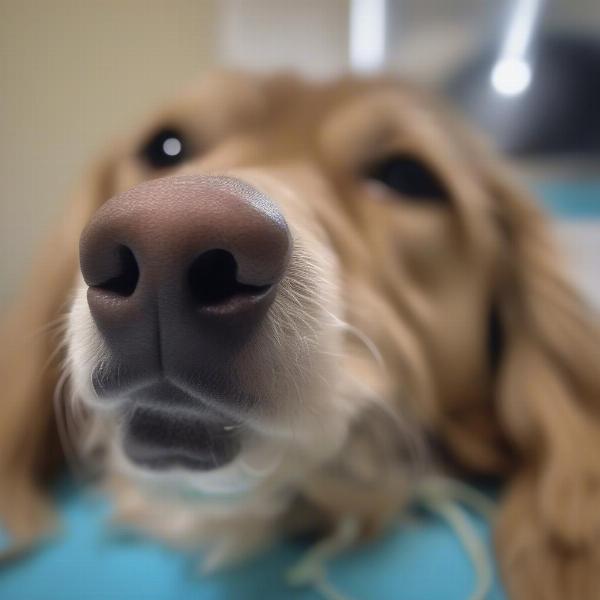After your furry friend undergoes a tooth extraction, proper aftercare is crucial for a smooth recovery and to prevent complications. This guide provides detailed information on how to care for your dog after tooth extraction, ensuring they heal comfortably and quickly. We’ll cover everything from pain management and feeding to potential complications and when to seek veterinary attention.
Understanding the Importance of Post-Extraction Care
 Dog recovering after tooth extraction
Dog recovering after tooth extraction
Dog tooth extraction, while sometimes necessary, is a surgical procedure that requires careful post-operative care. Without proper attention, your dog can experience pain, infection, and delayed healing. Understanding what to expect and how to provide the best care will contribute significantly to your dog’s well-being during this time.
Managing Pain and Discomfort
Pain management is a top priority after tooth extraction. Your vet will prescribe pain medication to keep your dog comfortable. Administer these medications exactly as directed. Never give human pain relievers to your dog, as many are toxic to them. Observe your dog for signs of pain, such as whining, restlessness, or decreased appetite. dog teeth removal
Signs of Pain in Dogs Post-Extraction
- Whining or whimpering
- Excessive drooling
- Reluctance to eat or drink
- Pawing at the mouth
- Restlessness or difficulty sleeping
If you notice any of these signs, contact your vet immediately.
Feeding Your Dog After Tooth Extraction
For the first few days after extraction, feed your dog soft food. Avoid dry kibble, hard treats, and toys that could irritate the surgical site. Canned food, softened kibble soaked in water, or specially formulated dental diets are good options. Ensure fresh water is always available. dog with braces
Keeping the Extraction Site Clean
Maintaining oral hygiene is vital to prevent infection. Your vet may recommend rinsing the extraction site with a prescribed solution or gently wiping it with a soft, damp cloth. Avoid brushing your dog’s teeth near the extraction site for at least two weeks.
What to Expect During Healing
Swelling and minor bleeding are normal for the first few days after extraction. You may also notice a small blood clot forming at the extraction site. This is part of the healing process. However, excessive bleeding, persistent swelling, or a foul odor from the mouth should be reported to your veterinarian immediately. cost for dog tooth extraction
Potential Complications
While rare, complications can occur after tooth extraction. These can include infection, dry socket (where the blood clot is dislodged), or nerve damage. Regular monitoring and following your vet’s instructions can help minimize these risks. how long does dog dental cleaning take
When to Contact Your Veterinarian
Contact your vet immediately if your dog exhibits any of the following:
- Excessive bleeding or swelling
- Foul odor from the mouth
- Loss of appetite or lethargy
- Difficulty breathing
- Signs of pain despite medication
Conclusion
Providing diligent aftercare following dog tooth extraction is vital for a comfortable and complication-free recovery. By following the guidelines outlined in this comprehensive guide, you can ensure your furry friend returns to their happy, healthy self in no time.
FAQ
- How long does it take for a dog to recover from tooth extraction? Most dogs recover within two weeks.
- Can my dog eat bones after tooth extraction? No, avoid hard chew toys and bones until fully healed.
- What if my dog dislodges the blood clot? Contact your veterinarian immediately.
- Is it normal for my dog to be sleepy after the procedure? Yes, drowsiness is a common side effect of anesthesia.
- When can I resume brushing my dog’s teeth? Wait at least two weeks, or as advised by your vet.
- Can I give my dog human pain medication? Never give human medication to your dog without consulting your vet.
- What are the signs of infection after tooth extraction? Swelling, redness, pus, and bad breath are signs of infection.
Related Articles on ILM Dog
About ILM Dog
ILM Dog (https://ilmdog.com) is your trusted resource for expert advice on dog care, offering comprehensive guides on everything from breed selection and training to health, nutrition, and grooming. We’re committed to providing dog owners with the knowledge and resources they need to ensure their furry companions live long, healthy, and happy lives. Our expertise in dog health and wellness ensures you’re equipped with the best information for your dog’s post-operative care. Contact us for personalized advice or more information via email at [email protected] or phone at +44 20-3965-8624.